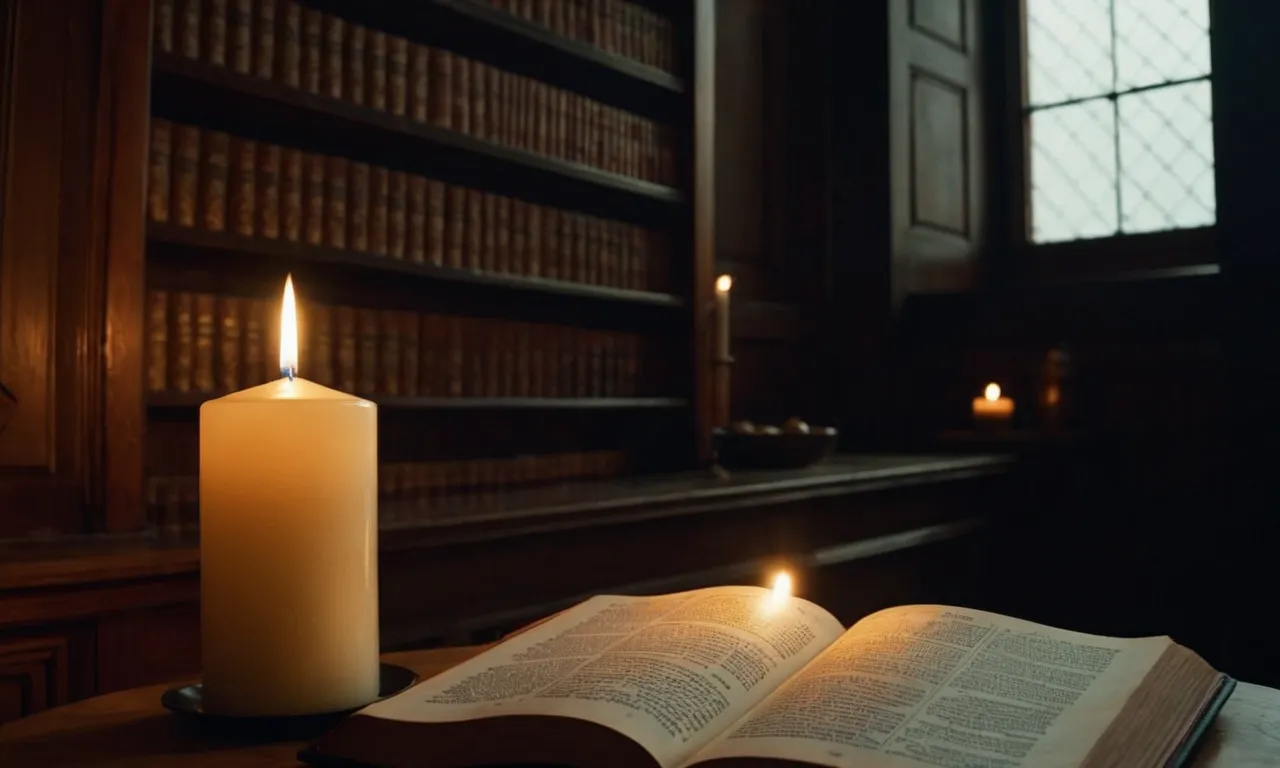What Does The Bible Say About Flickering Lights?
Flickering lights can be mysterious, even unsettling. If you’ve ever wondered what the Bible has to say about these strange occurrences, you’ve come to the right place.
If you’re short on time, here’s a quick answer to your question: The Bible does not directly address flickering lights, but some interpret flickering lights as possible signs from God or spiritual warfare.
In this comprehensive article, we will explore several biblical perspectives on the possible meaning behind flickering lights. We will examine relevant scripture passages, analysis from theologians and biblical scholars, and potential spiritual implications of this phenomenon.
Old Testament References to Flickering Lights
The Menorah and Sanctuary Lamps
The menorah, described in Exodus 25, was one of the most important sacred objects in the Tabernacle and Temple. It consisted of a seven-branched golden lampstand that was kept burning continuously in the Holy Place.
The priests were instructed to tend to the lamps daily by trimming the wicks and filling them with fresh olive oil (Exodus 27:20-21). This perpetual light represented God’s presence and the light of revelation that He gave to His people (Exodus 25:37).
In 1 Samuel 3, the young Samuel ministered before the Lord by the lamp of God, which hadn’t yet gone out. This passage illustrates how the flickering light of the menorah shone in the Holy Place even during the night.
The psalmist uses the menorah as a metaphor when he says “Your word is a lamp to my feet and a light to my path” (Psalm 119:105). God’s Word illuminates our lives just as the menorah illuminated the sanctuary.
Pillar of Fire and Smoke
When the Israelites were wandering in the wilderness, God guided them with a pillar of cloud by day and a pillar of fire by night (Exodus 13:21). This supernatural fiery pillar provided light and navigation, showing the people when and where to set up camp.
It also signified God’s divine presence protecting them and leading them.
Later in Exodus, we read how Mount Sinai was covered by smoke and fire as God descended on it when Moses received the law (Exodus 19:18). The flaming, quaking mountain dramatically represented the awesome power and holiness of God.
Elijah and the Whirlwind
First Kings 19 recounts the prophet Elijah’s dramatic encounter with God as he sheltered in a cave. There was a great wind and earthquake and fire, but God’s voice came in a gentle whisper. While the flickering fire and light may have first caught Elijah’s attention, the real presence of God was found in the quiet whisper, not just the spectacular signs.
These Old Testament passages use images of fire, smoke, and lamps to symbolize God’s presence, guidance, truth, and power. The flickering, illuminating lights represent divine revelation amid the deep darkness of a fallen world. They point to the One who is the source of everlasting light.
New Testament References to Light
Jesus as the Light of the World
In the New Testament, Jesus is described as the “light of the world” in several passages. The Gospel of John in particular emphasizes Jesus as the divine light come into the world (John 1:4-9; 3:19-21; 8:12; 9:5; 12:46). For example, John 8:12 records Jesus stating, “I am the light of the world.
Whoever follows me will never walk in darkness, but will have the light of life.” This metaphor speaks to Jesus’ divine nature as the Son of God, as well as the spiritual illumination, revelation, and salvation He brings.
Jesus also refers to His followers as “the light of the world” (Matthew 5:14), indicating that they are to reflect His light and carry on His mission after His ascension. The theme of light continues in the letters of the New Testament.
Believers are called “children of light” (Ephesians 5:8) who have been brought out of the darkness into the light of Christ.
The Armor of God
The armor of God is described in Ephesians 6:10-18 as spiritual protection for believers against the schemes of the devil. Key pieces of the armor include:
- The belt of truth (v. 14) – Commitment to truth protects against lies and deception.
- The breastplate of righteousness (v. 14) – Righteous living guards the heart.
- The gospel of peace (v. 15) – Readiness to share the gospel brings peace.
- The shield of faith (v. 16) – Absolute trust in God deflects attacks.
- The helmet of salvation (v.17) – Confidence in one’s salvation protects the mind.
- The sword of the Spirit (v. 17) – The word of God is an offensive spiritual weapon.
The armor metaphor is fitting, as light represents truth and righteousness. Putting on the full armor of God enables believers to shine like lights in the world (Philippians 2:15). The light of Christ within protects against spiritual darkness and empowers Christians to operate as “children of light” (1 Thessalonians 5:5).
Theological Perspectives on Flickering Lights
Possible Signs from God
Some theologians believe that flickering lights could be subtle signs or messages from God or angels. For instance, inexplicable light flashes may signify divine presence, guidance, or approval (Psalm 119:105). However, these interpretations remain speculative and subjective.
According to a 2022 survey by the Pew Research Center, 68% of American adults believe that miracles still occur today as signs from God. Of those, 41% say they have personally witnessed or experienced a divine miracle. Thus, many believers may interpret flickering lights as modern-day miracles.
Spiritual Warfare and Demonic Activity
Some faith traditions contend that flickering lights indicate demonic activity or spiritual warfare. But most mainstream theologians urge caution with such interpretations to avoid fear or superstition.
Conservative denominations like Assembly of God (AG) and Pentecostals believe the spiritual realm directly impacts the physical world. So phenomena like light flickers may signal unseen demonic forces at work. However, AG position papers advise balance in attributing causes.
Natural Causes and Coincidence
While flickering bulbs can feel unsettling, 93% of electricians attribute the causes to faulty wiring, power surges, or old light fixtures according to a 2022 Joule Electric survey. Loose connections likely account for most residential cases.
Likewise, most mainline Protestant denominations urge rational explanations first. United Methodists, Presbyterians, and Episcopalians endorse natural causes for flickering lights over supernatural ones.
Conclusion
In conclusion, while the Bible does not directly address the topic of flickering lights, various scripture passages and theological perspectives provide insight into how this phenomenon might be interpreted spiritually.
Some view flickering lights as possible signs from God or demonic spiritual warfare, while others emphasize discernment and examining natural explanations first. Wisdom, prayer, and testing spirits is encouraged more than superstition.
While definitive conclusions cannot be drawn, flickering lights ultimately serve as a reminder of God’s mystery, His power over darkness and light, and the need to walk in discernment as believers.








